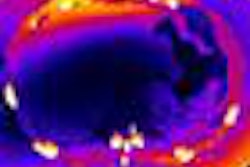Researchers at Mayo Clinic have developed an accurate new software tool to distinguish aggressive from nonagressive pulmonary adenocarcinomas, according to a pilot study published online April 8 in the Journal of Thoracic Oncology.
The computer-aided nodule assessment and risk yield (CANARY) software is designed to identify pulmonary nodules that are aggressive and potentially cancerous from those that are not aggressive and potentially could be treated with less extensive surgery. The software can noninvasively stratify the risk that lung adenocarcinomas can pose by characterizing the nodule as aggressive or indolent. Indolent was defined as either being an adenocarcinoma in situ or a minimally invasive adenocarcinoma.
It uses data obtained from existing high-resolution diagnostic or screening CT scans. The CT images of pulmonary adenocarcinomas match each pixel of a lung nodule to one of nine unique radiological characteristics.
Senior author and pulmonologist Dr. Tobias Peikert and colleagues created a training set of 54 pulmonary nodules of the adenocarcinoma spectrum and validated in 86 consecutively resected nodules. Radiologic measurements of the histopathologic tissue invasion were made. Nodules were isolated, then characterized by computer-aided analysis as aggressive or indolent -- defined as an adenocarcinoma in situ or minimally invasive adenocarcinoma.
The CANARY classification of the lesions had excellent correlation with the microscopic analysis of the surgically removed lesions, the authors wrote. The sensitivity for the detection of aggressive lesions was 95.4% in the training set, compared with 98.7% based on pathology. Specificity was 96.8 by CANARY and 94.9% in the validation set, and positive predictive value was 95.4% versus 87.5%, respectively.
"While CT lung cancer screening has been shown to improve patient survival, the initiation of a nationwide screening program would carry the risk of overtreatment of slow-growing tumors and would be associated with substantial healthcare costs," the authors noted. They hope that the CANARY software represents a new tool to potentially address these issues.




















